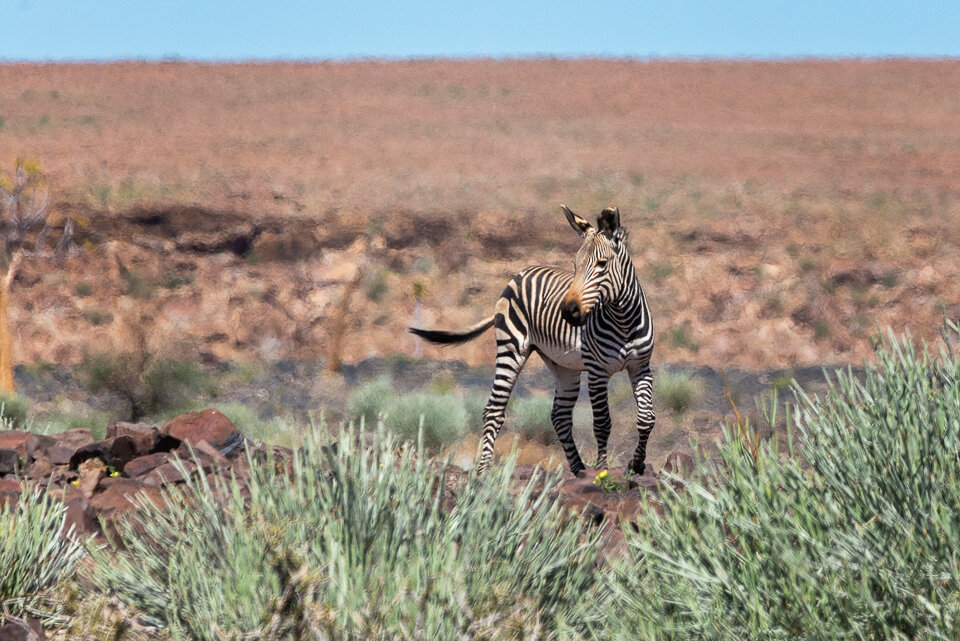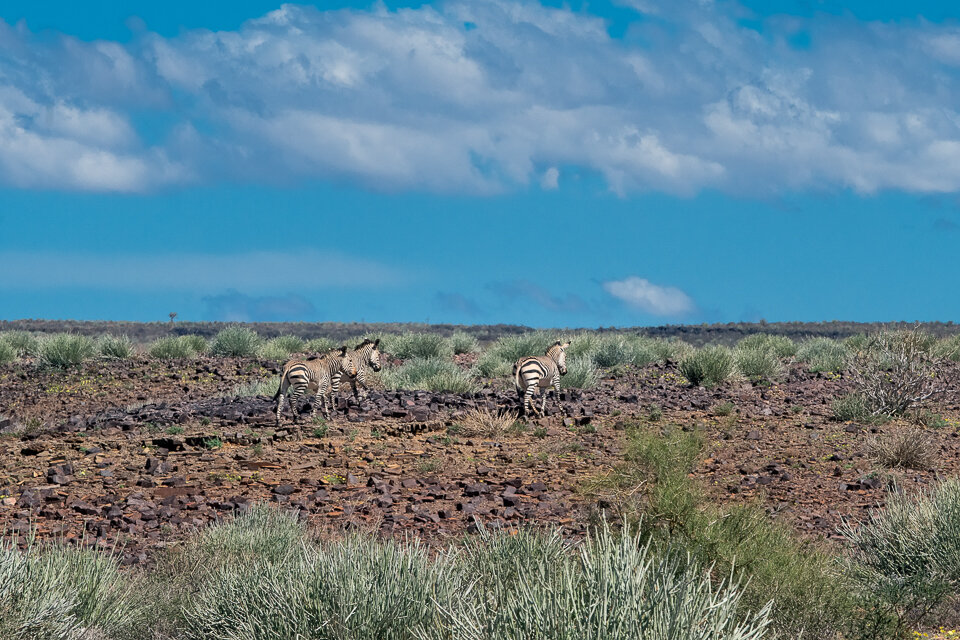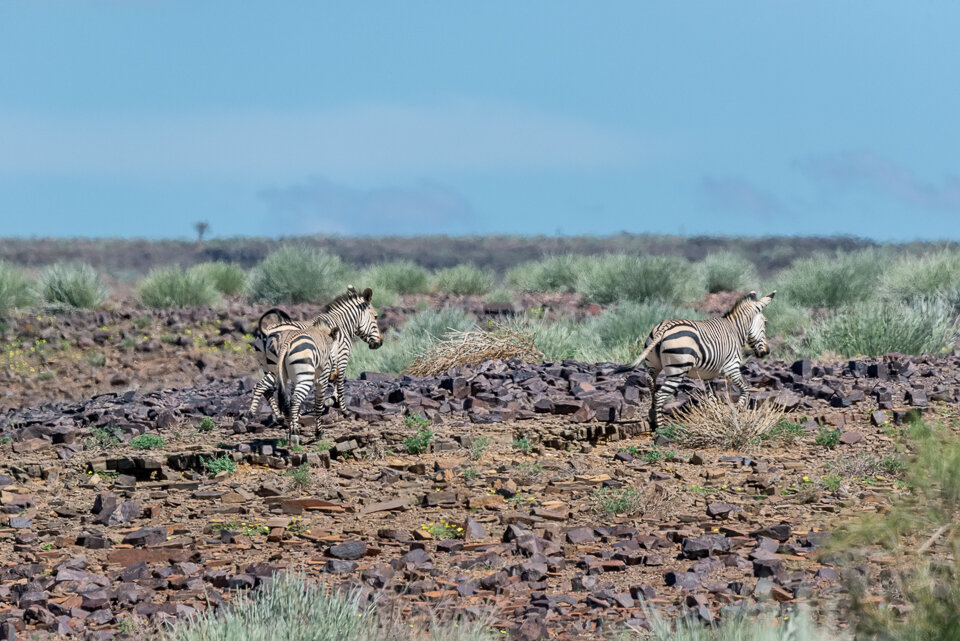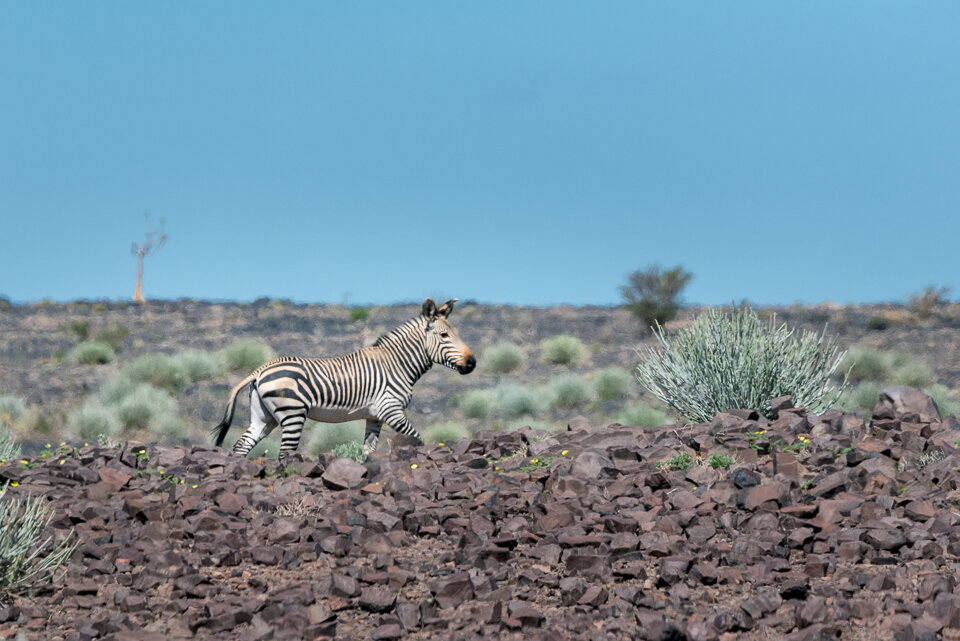There are two species of zebra in Namibia: the plains zebras (Equus quagga) and the mountain zebras (Equus zebra). The plains zebra present in Namibia - Burchell’s zebra - is easily identified by the brown additional faint “shadow-stripes” superimposed between typical black and white pattern. Mountain zebras do not have these extra stripes. Another easy to spot difference is the stripes length; the stripes of the plains zebras go all the way throughout the belly but the mountain zebras have white bellies without any stripes (apart from the one horizontal line going through the length of their underbellies). The legs are kind of opposite: the stripes of the mountain zebras are well visible throughout whole legs, down to the hooves, whereas the lower part of the leg of the plains zebra have stripes much less visible, substantially paler below their underpants. The mountain zebras have so called “dewlap” - a flap of skin on their throats and the a grid-iron pattern across the top of their rumps, both characteristics unique for them.
W Namibii występują dwa gatunki zebry: zebry stepowe (Equus quagga) i zebry górskie (Equus zebra). Zebrę stepową występującą w Namibii – inaczej zwana zebrą Burchella - można łatwo rozpoznać po dodatkowych brązowych, słabiej widocznych „paskach-widmach” widocznych między typowym czarnym i białym wzorem. Zebry górskie tych dodatkowych pasków nie posiadają. Inną łatwą do zauważenia różnicą jest długość pasków - paski zebry stepowej biegną przez cały brzuch natomiast zebry górskie mają białe brzuchy bez żadnych pasków (z wyjątkiem jednej ale poziomej linii biegnącej wzdłuż ich podbrzusza). Z nogami jest w pewnym sensie odwrotnie: paski zebry górskiej są dobrze widoczne na całych nogach, aż do kopyt, podczas gdy dolna część nóg zebry stepowej ma znacznie mniej widoczne paskowanie. Zebry górskie mają tak zwane „podgardle”, tj, mały płat skóry widoczny pod gardłem a także wzór kratownicowy na wierzchołkach zadów - obie te cechy są wyjątkowe dla tego gatunku.
By the way, if you think that zebras are white animals with black stripes, you are wrong. Embryological evidence shows that that zebras are black and the white stripes (and sometimes white bellies) develop later. Each zebra has a unique pattern of stripes, just as each person has his/her own individual fingerprints.
Nawiasem mówiąc, jeśli ktoś myśli, że zebry to białe zwierzęta z czarnymi paskami, to się myli. Dowody embriologiczne pokazują, że zebry są czarne, a białe paski i ewentualnie białe brzuchy rozwijają się później. Każda zebra ma unikalny wzór pasków, tak jak każda osoba ma swoje indywidualne odciski palców.
The Hartmann’s mountain zebra (depicted in this blog entry) is rare and we are thrilled we had a chance to observe them in nature. Hartmann’s zebra live in small breeding groups of four-five animals, that is one stallion with his mares and foals. Breeding herds remain stable over many years and mares usually remain in a herd for life. When they graze or travel, stallion is usually slightly behind the group, ready to protect his family with his powerful kick in back legs. So powerful it is, it can kill a spotted hyena and sometimes even deter a lion. Mountain zebras are good climbers which is supported by hard and pointed hooves and they are gifted with excellent night vision. They like to play together (chase, race, play-fight) and they also groom each other.
Zebra górska Hartmanna (to ją widzicie tutaj na zdjęciach) żyje w małych grupach składających się z czterech do pięciu zwierząt - jednego ogiera z jego klaczami i źrebakami. Stada hodowlane pozostają stabilne przez wiele lat, a klacze zwykle pozostają w swoim stadzie przez całe życie. Gdy się pasą lub podróżują, ogier zwykle znajduje się nieco za grupą, gotowy chronić swoją rodzinę potężnym kopniakiem tylnych nóg. A kopniak ten ma w sobie taka siłę, że może zabić hienę cętkowaną, a czasem nawet odstraszyć lwa. Zebry górskie są dobrymi wspinaczami, w czym pomagają im twarde, spiczaste kopyta i są one także obdarzone zdolnością bardzo dobrego widzenia w nocy (na poziomie zbliżonym do sów). Zebry Hartmanna lubią się razem bawić (berek, wyścigi, walki na niby), a także pielęgnują nie tylko siebie, ale także swoich towarzyszy.
Zebras mainly feed on grass and their stomachs always look full because they are filled with gas, bloated, a side effect of fermentation bacteria doing its job to support digestion. And yes, they do pass a lot of wind. The benefit is, they can survive on diets of lower nutritional quality than what would be necessary for other herbivores.
Zebry żywią się głównie trawą, a ich żołądki zawsze wyglądają na krągłe, ponieważ są wypełnione gazem, efektem ubocznym działania bakterii fermentacyjnych, które pomagają w trawieniu ale powodują wzdęcia. I tak, zebry puszczają wiatry dość często. Korzyścią jest to, że mogą one przetrwać na dietach o niższej jakości odżywczej niż byłoby to konieczne dla innych roślinożerców.






